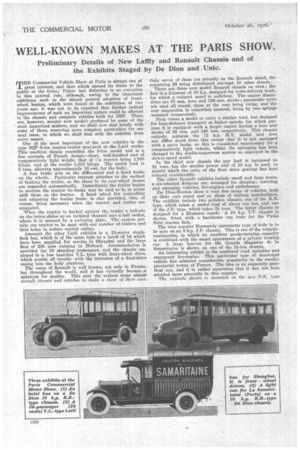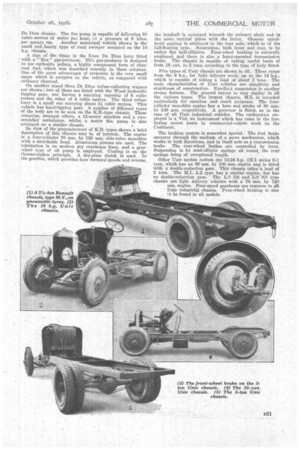WELL-KNOWN MAKES AT THE PARIS SHOW.
Page 52

Page 53

If you've noticed an error in this article please click here to report it so we can fix it.
Preliminary Details of New Laffly and Renault Chassis and of the Exhibits Staged by De Dion and Unic.
THE Commercial Vehicle Show at Paris is always one of great interest, and that which opened its doors to the public at the Gram: Palais last Saturday is no exception to this general rule, although, owing to the important additions, such as the almost general adoption of frontwheel brakes, which were found at the exhibition of two years ago, it was not to be expected that further radical improvements of such an important nature could be effected in the chassis and complete vehicles built for 1927. There are, however, severai new models produced by some of the most important makers, and we shall now deal briefly with some of these, reserving more complete particulars for our next issue, in which we shall deal with the exhibits from every aspect.
One of the most important ef the new vehicles is the type BF 5-ton tractor-trailer produced at the Latil works. This machine closely resembles the 8-ton model and is a fine example of French design----clean, well-finished and of comparatively light weight, that of te tractor being 1,700 kilogs. and of the trailer 1,310 kings. The useful load is 5 tons, allowing approximately 16 cwt. for the body.
A foot brake acts on the differential and a hand brake on the wheels. Particular interest attaches to the method of braking the trailer, as the shoes in its rear-wheel drums are expanded automatically. Immediately the trailer begins to overrun the tractor its .brake may be said to be in series with those on the tractor. A hand wheel for controlling and adjusting the trailer brake is also provided, this, of course, being necessary when the tractor and trailer are separated.
When the tractor is backed against the trailer a ball-pin on the latter-slides up an inclined channel into a ball socket, where it is secured by a swinging plate. The system permits one tractor to be used -with any number of trailers and thus helps to reduce capital outlay.
Amongst the other Lath l exhibits is a 24-seater singledeck bus, which is of the same type as a batch of 14 which have been supplied for service in Shanghai and the large fleet of 250 now running in Holland. Accommodation is provided for 10 standing passengers, and the chassis employed is a low load-line V.L. type with front-wheel drive, which avoids all trouble with the intrusion of a final-drive casing into the body platform.
The name of Renault is well known, not only in France, but throughout the world, and it has virtually becorne..a synonym for quality. This year the makers stage almost enough chassis and vehicles to make a show of their own. Only seven of these are actually on the Renault stand, the remaining 26 being distributed amongst 10 other stands. , There are three new model Renault chassis on view; the first is a 2-tonner of 10 h.p. designed for town-delivery work, for which a reduced speed is sufficient. The engine dimensions are 75 mm. bore and 120 mra. stroke ; pneumatic tyres are used all round, those at the rear being twins, and the rear suspension is somewhat unusual, being by two springs mounted transversely.
Next comes a model to carry a similar load, but designed for long-distance transport at higher speeds, for which purpose it is equipred with a larger engine having a bore and stroke of 85 mm. and 140 ram. respectively. This chassis entirely replaces the 15 h.p. M.Y. model and does not differ much from this except that it is not equipped with a servo brake, as this is considered unnecessary for a comparatively light vehicle, whilst the springing has been changed to the double-transverse system as employed in the slower-speed model.
In the third new chassis the pay load is increased to 2i tons, but the smaller power unit of 10 h.p. is used, to permit which -the ratio of the final drive gearing has been reduced considerably.
The other Renault exhibits include small and large buses, a six-wheeled Saharan car, arranged for sleeping; watering and sweeping vehicles, tire-engines and ambulances.
Be Dion-Bouton show a very fine range of vehicles, both on their own stand and on those of various bodybuilders. The exhibits include two polishen chassis, one of the K.B. type, which takes a useful load of about one ton, and one of the J.E. type' which takes 24 tons. The latter chassis is designed for a 22-seater coach. A 10 h.p. I.T. chassis is shown, fitted. with, a handsome van body for the Bathe Bebe cinema firm.
The very popular Normandy carnionette type of body is to be seen on an 8 h.p. J.P. chassis. This is one of the torpedocamionettes, in which an excellent goods-carrying capacity is combined with the smart appearance of a. private touring ear. A large boxvau for the Orands Magasins de In Samaritaine is shown on one of the 2i-ton chassis.
An interesting exhibit is the combined road sprinkler and emergency fire-engine. This particular type of municipal vehicle has achieved considerable popularity in the smaller provincial towns of France. The idea is an eminently practical one, and it is rather surprising that it has not been adopted more generally in this country.
The example shown is mounted ou the new O.K. type
De Dion chassis. The fire pump is capable of delivering 60 cubic metres of water per hour, a a pressure of 9 kilos. per square cm. Another municipal vehicle shown is the small.and.handy type of road sweeper mounted on the 10 h.p. chassis. .
A sign of the times is the 5-ton De Dion lorry fitted with a " Rex" gas-pro iucer. This gas-producer is designed to use carbonite pellets, a highly compressed form of charcoal fuel, which was described recently in these columns. One of the great advantages of caroonite is the very small space which it occupies on the vehicle, as compared with ordinary charcoal.
On another stand three De Dion refuse-collecting wagons are shown ; two of these are fitted with the Wood hydraulic tipping gear, one having a carrying capacity of 6 cubic metres and the other of 4 cubic metres. The third refuse lorry is a small one carrying about 11 cubic metres. This vehicle has hand-tipping gear. A number of different types of the body are to be seen on the K.B.-type chassis. These comprise, amongst others, a 12-seater omnibus and a twostretcher ambulance, whilst a motor fire pump is also arranged on a similar chassis.
In view of the preponderance of K.B. types shown a brief description of this chassis may be of interest. The engine is a four-cylinder 70 MM. by 120 mm. side-valve monobloc with a detachable head. Aluminium pistons are used. The lubrication is on modern dry crankcase lines, and a gearwheel type of oil pump is employed. Cooling is on the thermo-siphon principle. A dry-plate clutch is used. In the gearbox, which provides four forward speeds and reverse, the layshaft is arranged beneath the primary shaft and in the same vertical plane with the latter. Gleason spiralbevel gearing is employed in the rear axle, which is of the full-floating type. Suspension, both front and rear, is by rather flat half-ellipties. Four-wheel braking is naturally employed, and there is also a hand-operated transmission brake. The chassis is capable of taking useful loads of from 18 cwt. to 2 tons, according to the type of body fitted.
Five types of Unic chassis are shown in all. These range from the 9 h.p., for light delivery work, up to the 14 h.p., which is capable of taking a load of about 3 tons. The main characteristics of Unic vehicles are simplicity and sturdiness of construction. Excellent suspension is another strong feature. The general layout is very similar in all the various types. The largest chassis, 3/1.5, is intended particularly for omnibus and coach purposes. The fourcylinder monobloc engine has a bore and stroke of 80 mm. by 148 ram. respectively. A governor is fitted, as in the case of all Unic industrial vehicles. The carburetter employed is a Viel, an instrument which has come to the fore during recent years in commercial-vehicle work on the Continent.
The braking system is somewhat special. The foot brake operates through the medium of a servo mechanism, which works in both directions, and in itself acts as a transmission brake. The rear-wheel brakes are controlled by lever. Suspension is by semi-elliptic springs all round, the rear springs being of exceptional length.
Other Unic models include the 12-24 h.p. (14.1. series O.) type, which has an 80 mm. by 130 mm. engine an is fitted with a double-reduction gear. This chassis takes a load of 2 tons. The XL £2 type has a similar engine, but has no double-reduction gear. The L.2 D2 and L.2 N2 type chassis are light delivery vehicles with a 70 mm. by 120 mm. engine. Four-speed gearboxes are common to all
Unic industrial chassis. Four-wheel braking is also 10 be found in all models.




































































































